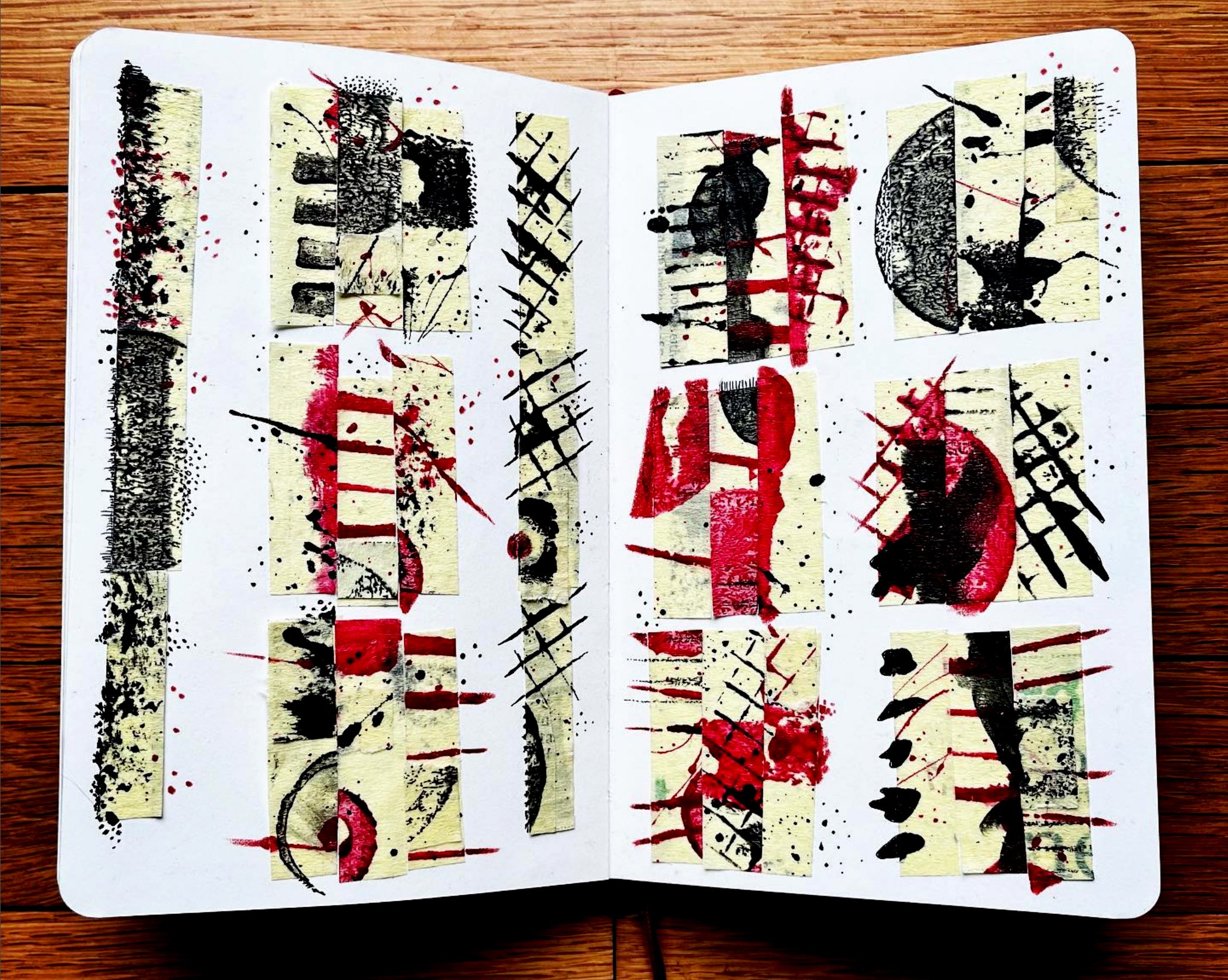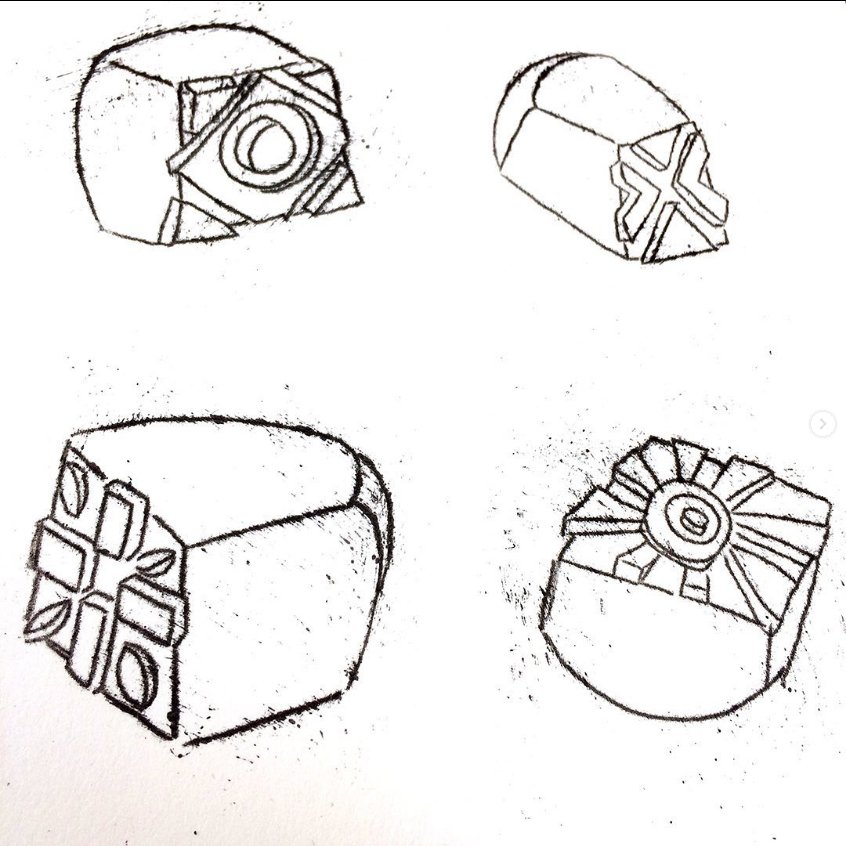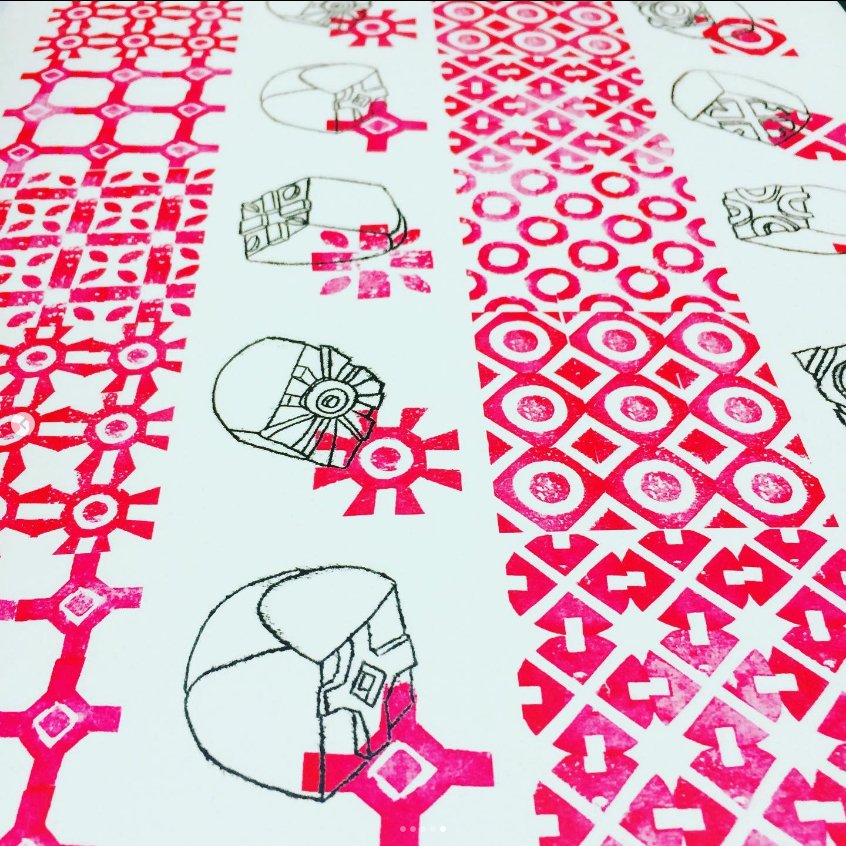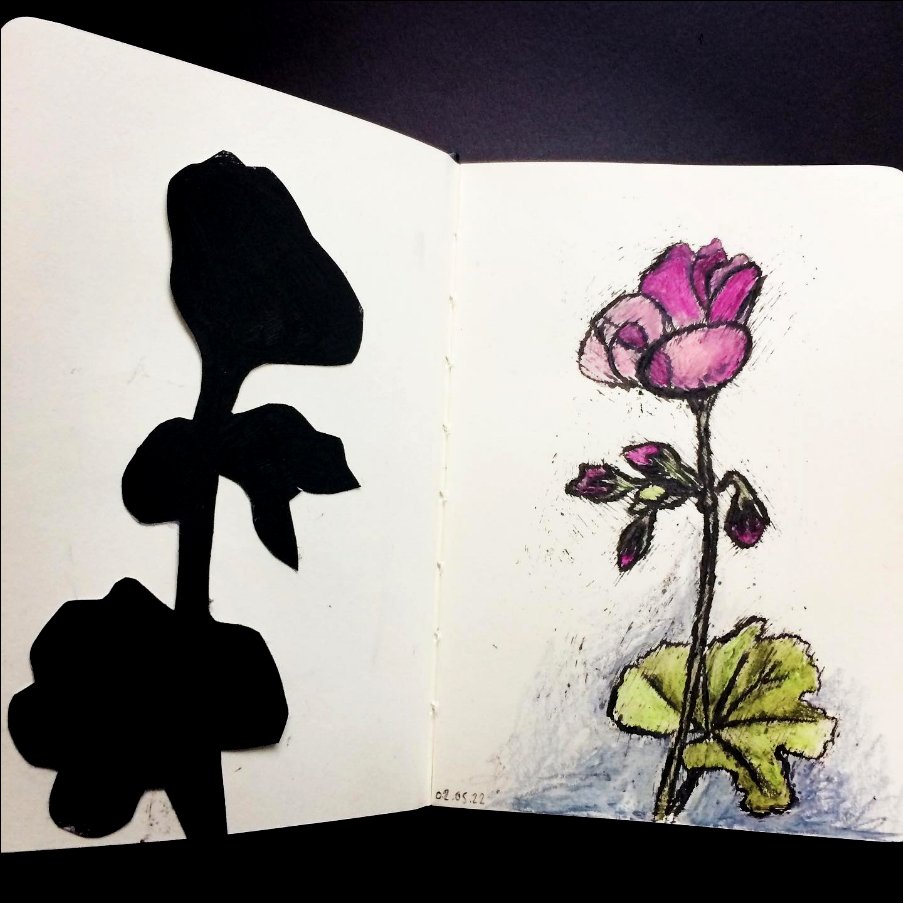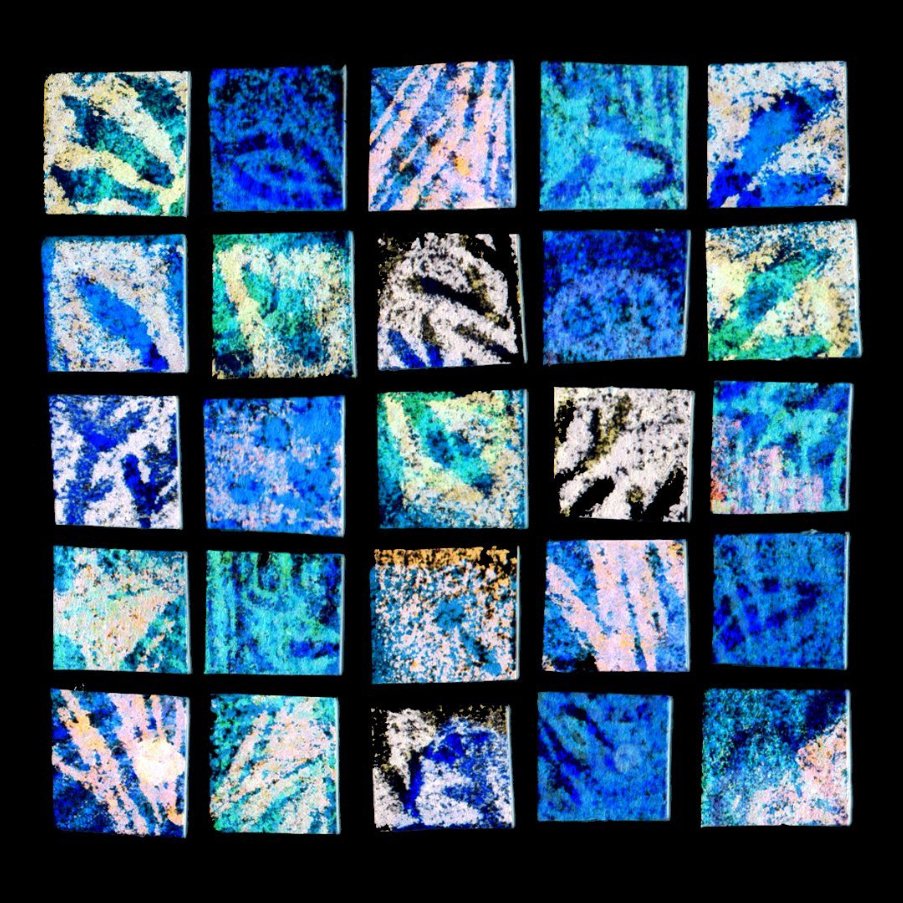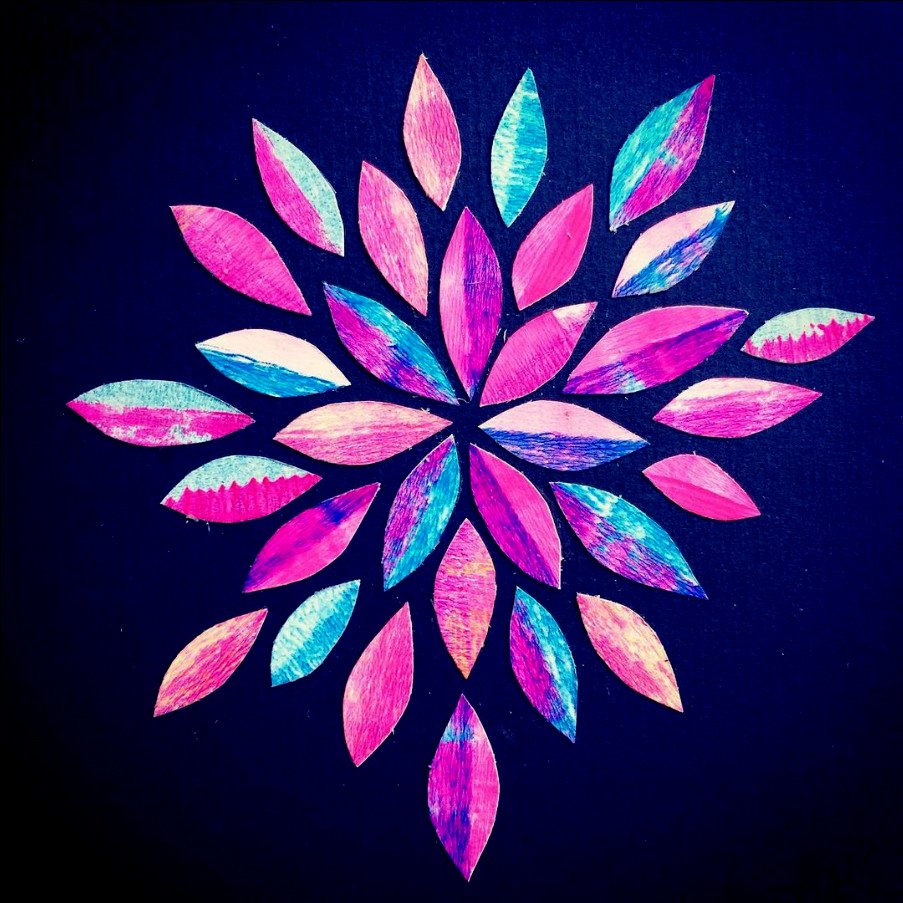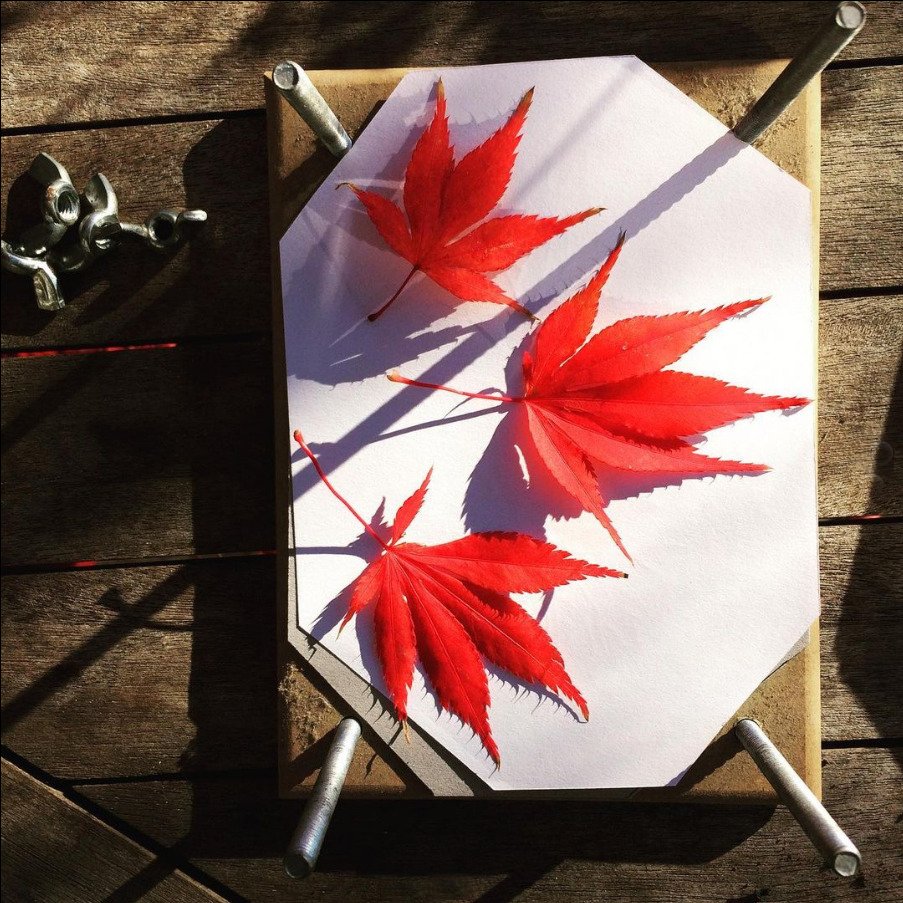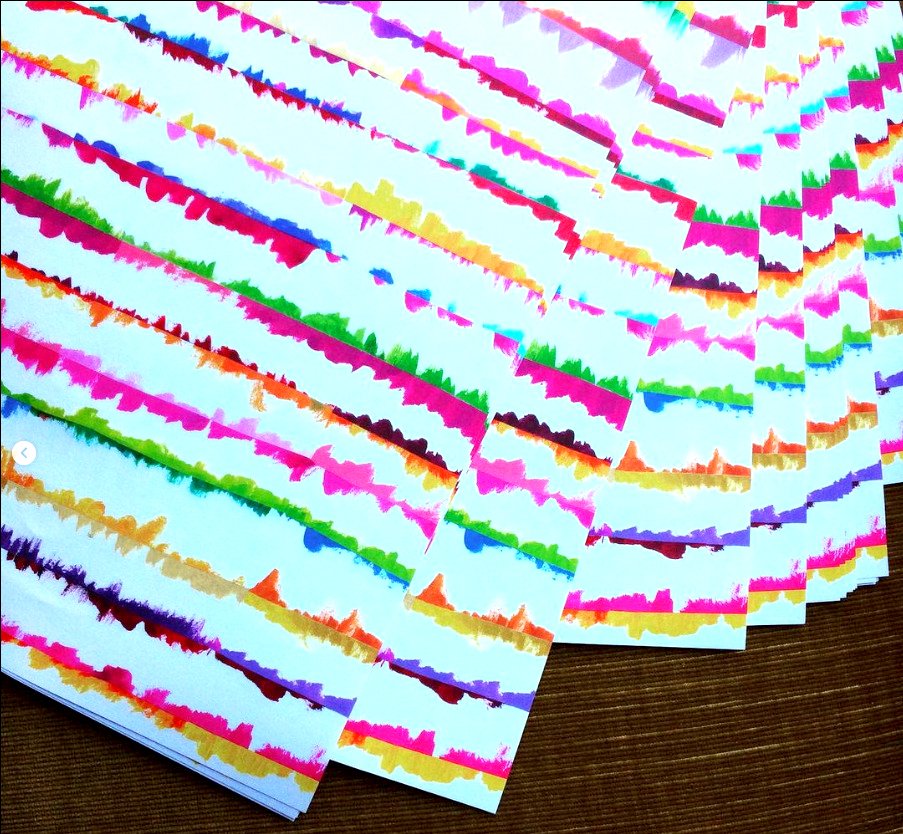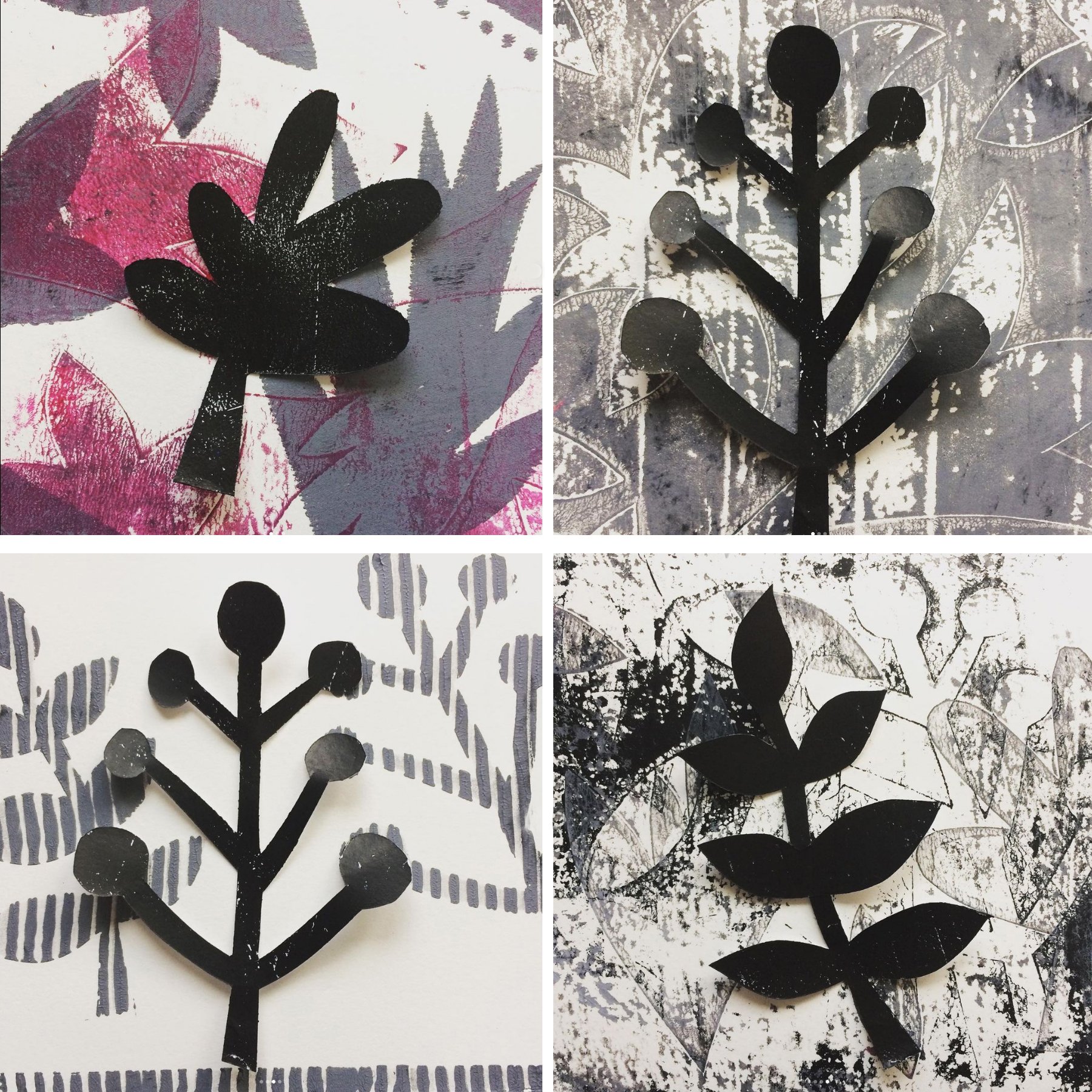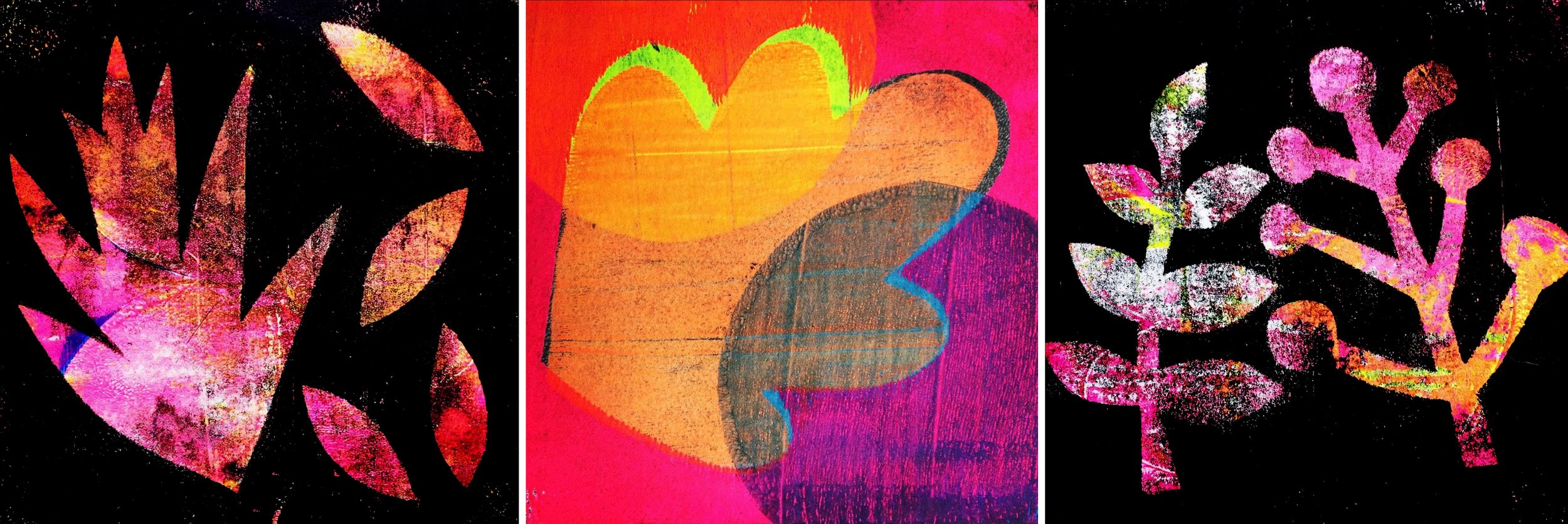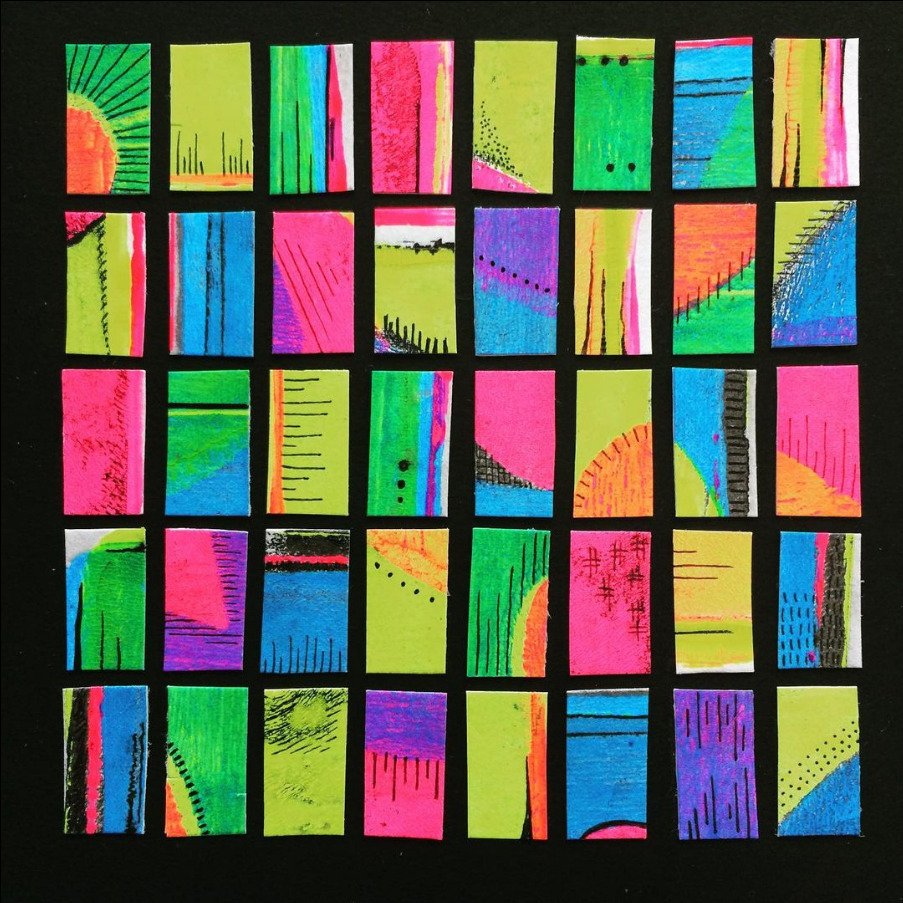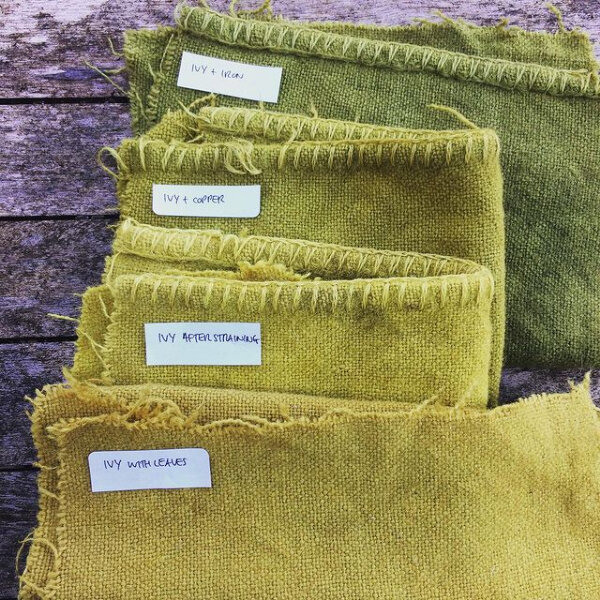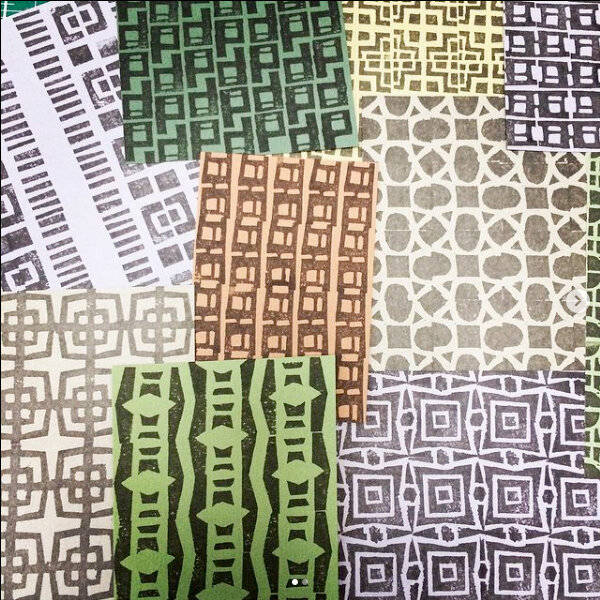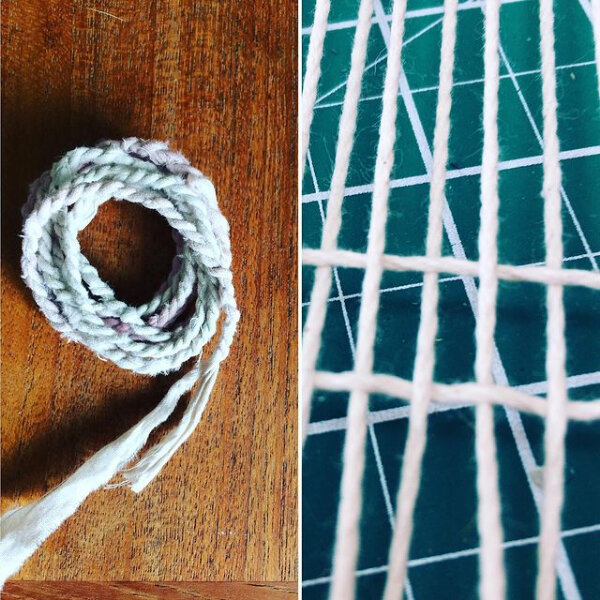Feeling hopeful and positive for the first time in a long while following the general election here in the UK on 4 July. After 14 years of chaos and decline, we finally have some grown ups in charge again. Hallejulah. I made a limited edition of these rubber stamped prints to celebrate the change the government – there’s a small handful left now in my online shop if you’d like one as a memento… UPDATE: Many thanks to everyone who bought a print – the edition of 24 is now sold out.
POTATO
A new book I’ve made is currently being exhibited in the ‘Pattern:Books’ exhibition at the Upright Gallery in Edinburgh… Artist bookmakers were invited to submit artworks for the annual artist book exhibition held every December. The brief was to celebrate pattern in artist book form. Over 80 handmade books are on display from 35 artists in an exhibition co-curated with Edinburgh based artist book maker and tutor Susie Wilson.
The book POTATO is a digitally printed edition of potato prints and backdrawn monoprints. Started as an experiment in making printed repeat patterns with carved potatoes at my kitchen table, I then drew the carved potatoes as backdrawn monoprints. It’s fun to see the book travelling up to Edinburgh to be exhibited, and then making it onto the cover of Art Mag at the beginning of December. An exciting journey for a handful of humble potatoes.
Week 5 – rubber stamps
Small verbena flowers
The sepals of a rock rose
The sepals of a geum
The daisy-like flowers of Mexican fleabane
Snow-in-summer flowers
A week of carving simple rubber stamps based on plant shapes to create repeat patterns.
Draw More May
Monoprint, rubber stamps and collage
Monoprint, water-soluble crayon and collage
Monoprint, foam stamps and posca pen
Monoprint and watercolour
Monoprint, gouache and rubber stamp
Trying to get back into a daily practice of drawing this month (possibly limited to weekdays). This first week I’ve been playing with back-drawn monoprints, and - as I’m always more fond of the left behind bits - adding an additional page using leftovers each day…
Week fifty one
Pressed (and nibbled) Geranium leaves
Sunflower dye results
My Christmas card this year
I’ve uncovered some weird and wonderful geranium leaves out of the flowerpress. Not sure what had been nibbling them to create such impressive doilification (is that a word?!) I’ll store these to make some cyanotypes next year when the sun makes a welcome return.
A soft range of colours from dyeing sunflower heads. More like the seeds than the flowers. These were a pretty standard variety, but I also attempted to grow black Hopi sunflowers (meant to be excellent for dyeing) this year after @sixhq kindly sent me some seeds back in the Spring. Even in pots on gravel, they proved irresistible to the slugs, but I managed to at least grow enough to collect more seed to try again next year.
This is my Christmas card this year – a (slightly doctored) cyanotype of hydrangea petal skeletons from my garden. Made in summer but it felt suitably wintery. Wishing everyone reading this a very relaxing and festive season wherever you are (and whatever restrictions you may be facing).
Week forty nine
Paper stencils from November’s polyprints
Collage of chopped up test sheets from polyprints
Another polyprint test sheet collage
And an inverse image in Photoshop
Dye results from iris tubers
I kept the paper stencils cut for November’s polyprints. I really like the chunky quality of the shapes and would like to use this as a starting point for new work. Maybe a woodcut? Or an embroidery? Or even another collage?
Using up more waste material… I chopped up the test sheets from last month’s polyprints... interesting colour combinations and texture. I inversed one of the scans in Photoshop and I was fascinated by how different it looks when the colour palette is altered.
I’d read that dye could be made from iris root (tubers)... I was moving some irises from the front garden, so decided to test it out. Not quite the colour punch I was hoping for, but some pleasant-enough teddy bear browns in the yarn and woollen blanket (looks a bit more ochre in this photo than it does in real life).
Week forty eight
Polyprinted daily drawings for November
Random print with leftover, used polyprint plates
Collage made from filter paper from making black dahlia ink
November’s sheet of daily drawings are now complete – this month I made polyprints (using plates similar to frozen pizza base packaging). I have a lot less control and the results are a lot more rough and ready than I’m used to, but I’ve really enjoyed the challenge of working out the potential of this ultra low tech form of printmaking.
I used the leftover, used polyprint plates to make a random grid print of overlays – interesting to see the unexpected textures that emerge from working like this. I’d definitely like to experiment more with polyprints in the future.
The coffee filter paper used for making my black dahlia ink a ouple of weeks ago was too enticing to throw away. Instead I made a small collage of a dahlia, with the background painted with the actual black dahlia ink.
Week forty seven
Hapazome print of nasturtium leaves
Hapazome print of acer leaves
Recent natural ink results
Offcuts collage
And another offcuts collage
I tried a few more focused experiments with hapazome printing (hammering leaves onto fabric to create a print). As the frosts polished off both the nasturtiums and acer leaves, I caught them just in time. The ochre fabric used for some of the acer prints was dyed with acer leaves from the same tree this time last year. I’m amazed at the detail of the leaf veins from the nasturtium leaves, and also surprised at the intensity of colour. It will be interesting to see how long it lasts.
As the colour rapidly disappears from the garden at this time of year, the appeal of making ink returns. Something very satisfying about bottling colour. There’s been a good colour range with my recent batches of ink… the black dahlia is particularly intense (and works better as an ink than as a dye). The French marigold is my favourite as it’s unusual to get a colour that is so definitively yellow (and not a shade of brown!)
Finally this week, I’ve been cutting up sheets of paper used for cleaning my rollers after recent monoprinting sessions. It’s my usual approach of rescuing paper before it gets to the recycling bin – always a joy to see random patterns and mark making emerging without thinking too hard about the end result.
Week forty six
Pressing acer leaves to preserve some of the colour
First attempt at hapazome printing
Another offcuts collage
A batch of printed wrapping paper
Black dahlia flowers – dye results
Trying to capture some of the amazing autumn colour outside my back door by pressing acer leaves (already hardly any left on the tree by the time I type this).
I made a first attempt at hapazome - the Japanese technique of creating prints from plant material by hammering with a mallet. Not overly successful – there was a lot of squashy splodges not shown here – but I could identify what has potential… hydrangea petals and leaves of acer, herb Robert and nasturtium...
Couldn’t quite bin what was left of the brush cleanig gouache strips, so I made another collage of the tiny offcuts (getting smaller!) I also received some wrapping paper back from the printers featuring a repeat pattern of my original collage of offcuts. Lovely job by printed.com
I grew dahlias for the first time this year... lost a few early on to ravenous molluscs, but the gorgeous black blooms made an appearance in July and have only just stopped flowering last week. I’ve been saving deadheaded flowers in the freezer and made this dye batch with them last week. A strong range of browns. Next year I’ll freeze them in an airtight container though... the musty smell taints ice - not a welcome addition to my G&T!
Week forty three
I made some simple paper stencils based on ink drawings of plants in my garden, and dusted off my gelli plate to make some monoprints. Much as I love the natural colour palettes I’ve been creating this year, I still can’t resist my tubes of fluorescent acrylics! I also made some others with a calmer colour palette that sit quite well with some of the used paper stencils.
After chopping up some of the gelli prints that didn’t go so well for collages, I was still left with tiny offcuts which I made into another collage. I always enjoy using up paper that was otherwise headed for the bin.
It’s been a week of play (slightly less busy with work as it’s half term and lots of my clients are on holiday). I carved some rubber stamps based on a collage I made of a cordyline in a pot as part of October’s daily drawings. l love the quick way you can try out different colour combinations with stamps, and also build up layers of colour and texture.
Week forty one
Back-drawn monoprint
Colouring up monoprints with natural inks
A soild version of the folded book of garden sketches I made in Norfolk last month
After the small back-drawn monoprints I made of seed heads last month, I decided to try something a bit more detailed. I made some quick sketches in the garden and then painted the back of them with black oil paint and traced them off to make simple monoprints. I then coloured them up with natural ink (black poppy, rhubarb root and acorn galls + iron oxide). The inks work well with the quality of line in the monoprints and soften the overall effect.
From analogue to digital… I’ve taken the line drawings from the folded book I made in Norfolk last month and played around with reversing areas in Photoshop to make solid shapes. An interesting exercise in balancing black and white. Some of these may be good starting points for trying out making tetra-pak prints. Possibly something for next month…
Week thirty nine
Back from holiday, and a quiet-ish week on the Garden Residency front as I catch up with work.
I completed my daily drawings for September - using gouache this month. It’s felt more of an exercise in colour mixing than in observation, but hopefully it captures some of the late-summer colour in various gardens this month (my own in Bristol, my parent’s in Shropshire and my holiday in Norfolk).
I had fun trying out my new set of brush pens with a drawing of cosmos and asters in the front garden... lovely bright colours in what was been a grey, rainy week. Definitely picked the right week for my holiday!
Inspired by the seedheads of hollyhocks in the garden where I’ve been staying in Norfolk, I carved and printed a new rubber stamp repeat pattern. I think this could work on both paper and fabric – I’m interested to scale it up a bit, and also to introduce some colour.
Week thirty five
My daily drawings for August - a collection of rubber stamp prints
The aforementioned rubber stamps!
An embroidered panel of naturally dyed wool
Limbering up for a month of daily drawings of gouache paintings
August has come to a close, and this month’s daily drawings are complete… all rubber stamps. This one has proved to be a little more time consuming, but they were mostly each completed within 15 minutes. Although it’s a technique I’m pretty familiar with, it’s still been a good learning exercise. Working out how best to simplify shapes, deal with negative space and incorporate fine details for stalks or petal markings. I now have a good stash of flowery rubber stamps that I can hopefully use in future projects.
Like the month of wax crayons, there’s a cohesion to the finished sheet of rubber stamps that comes from working with a set colour palette. I’m looking forward to mixing my own colours again next month though, when I’ll be using gouache for my daily drawings. I had a practice by doing a quick painting of a vase of flowers, and I think I’ll try to incorporate some coloured paper backgrounds to my daily drawing grid to make the inclusion of white flowers more possible.
As the month ended, I also finished a small embroidered panel I’ve been working on using naturally dyed yarn. I’m enjoying discovering the potential of embroidering with wool, relying on texture to build up a surface. It’s been a real pleasure choosing the colours and to see how they look together and interact with each other. There have been times over the past year when it’s felt like most of my dye results yield some form of ochre or brown, but this is encouraging proof that the palette is much wider than that.
Week thirty four
A small concertina book of seedhead drawings using black hellebore ink and backdrawn monoprints
Quick collage of post-it note masks used in making rubber stamp prints
Dye results from Rowan… leaves on the left and berries on the right
I’ve made my plant form drawings into a small concertina book - black hellebore ink with backdrawn paper monoprints on somerset paper. I like the combination of natural ink and monoprints and would definitely like to explore this combination further.
An unusual pop of colour in my garden residency... I’ve been carving a daily rubber stamp through August, and I’ve been masking areas off with post-it notes. I was about to clear the paper masks into the bin when I decided to stick them on a bright piece of paper instead. Instant collage gratification.
A surprising set of dye results from Rowan. The bright berries (photographed a couple of weeks ago) only gave out any bold colour onto silk and wool (see browns on the right hand photo) but the leaves - which I only boiled up as an afterthought as I only had a few - gave a wide range of ochres and browns across all the materials. Shows it’s worth splitting up plant material to get a wider range of colour - a useful lesson!
Week twenty nine
Cyanotype of Corydalis leaf
Cyanotypes of acer, passion flower and cosmos leaves
Early morning sketching in the front garden
Hand drawn map of the veg patch
The wide range of colour from Herb-robert
In the sprit of using this year of my ‘garden residency’ to try new techniques, I’ve dipped my toe in the chemical waters of cyanotypes. Making the most of the recent heatwave in the UK, I made some solar prints with leaves I’ve recently liberated from my flower press. Results were mixed, but it was an interesting introduction to the process, and I’d definitely like to try more.
Two types of ink drawing this week… one using a bamboo dip pen sat in my front garden very early on a sunday morning, and the other a stylised map of my veg patch (minus weeds and slug damage).
This week’s dye results were from the excellently named Herb-robert – a large weed that’s been growing out of the wall in the veg patch. A surprisingly strong colour for such a delicate plant, and a lovely range across all the different materials. Encouraged to try dyeing with more weeds now…
Week seventeen
Daily drawings in April (natural ink and masking fluid)
Scans of Acer leaves unfurling (once a week from the end of March)
Reconfigured grid drawing (acorn gall+ iron ink and masking fluid)
Grid drawing filled in with natural ink
Single sheet folded book of flowerpot base plasticine prints (and acrylic paint)
Carving and stamping one of the flowerpot prints to create a repeatable pattern
A week of continuing on with projects started earlier in the month… happy to complete April’s daily drawings (now one third of the way through the year - doesn’t time fly when you can’t go anywhere?!) The drawings this month were done with a ruling pen and masking fluid, then coloured with a range of natural inks. Some worked better than others, but I’d like to use these as a starting point for some embroidered drawings. Edging slowly towards using colour as the garden begins to brighten up.
I’ve been scanning buds/leaves from the Acer tree outside my studio each week since the end of March. Fascinating to see the progress of the leaes as the tree comes into full leaf. I’m going to try to remember to keep scanning monthly from now on to capture the colour changes between now and October. I made the sequence into a short animation, which you can see on my Instagram feed.
I photocopied my garden grid drawing from last week and cut each square in half to reconfigure the layout. I tried this out in monochrome with acorn gall/iron ink and then masked out a second version for natural inks. It feels like work in progress rather than a finished piece, but I’m interested to see how it’s shifting into quilty territory. This garden residency is confirming my longstanding interest in switching between paper and fabric.
I also re-visited my flowerpot base plasticine prints - making an A4 sheet of prints into a folded single sheet book (the colour is neon pink acrylic, but looks like a flat red in the photo). Frustrated by the ephemeral nature of the plasticine, I traced one of the early prints and carved it in rubber. This makes a stable block to create a repeat pattern… unexpectedly starts to feel a little like a medieval tiled pattern. Not sure the bottoms of plastic flowerpots were the original inspiration for church floors all those centuries ago!
Week fifteen
Plasticine prints of the bottoms of flowerpots
The pots in question
Collage of dragon leaf fern prints (with ink made from rhubarb root)
paper weaving with natural ink sample offcuts
A short film I made about my concertina books for BABE 2021
A rather less productive week as I’ve been pitched back into catching up with work. The week ended with BABE 2021 – The Lost Weekend…. an online celebration of artist’s books to replace the usual amazing event in Bristol that was due to be held this year. Not the same as a real life book fair, but a wonderful chance to take part in some collaborative projects and to watch short films made by lots of other book artists (still available to watch here). I made one about five of my concertina books – illustrating the versatility of my very favourite book format, and showing some of my processes and inspirations – you can view it here).
One of the collaborative challenges set for BABE 2021 was to photograph or trace the backs of things… I made some plasticine prints of the bottoms of flowerpots from my shed. I really liked the bold patterns, and plan to carve some rubber stamps based on these prints. I also printed the backs of some dragon leaf ferns - less successful as a print, so I cut it up and made a grid collage using masking fluid and rhubarb root ink. It starts to look like tiger fur!
Finally, some simple paper weaving using more offcuts of my natural ink samples – I’m interested to see the crossover between paper and textile work that’s evolving as part of this ‘garden residency’.
Week eleven
Collages made from homemade ink sample sheet – embellished with catkin ink
Map-like collage with tiny offcuts from ink sample sheet
Different greens extracted from ivy dye
Pattern overload – based on shapes from my garden map drawings
Crocosmia and Nicotiana seeds arrived from Scotland… so pleased to be part of this Seed Library project (See @Plot_55b on Instagram for more information)
A quieter week on the Garden Residency for a couple of reasons… I’m very busy with work, but also as the weather warms up and it’s been dry, a lot of my spare time has been spent either sowing seeds or preparing the garden for a new season of growing things. I need to work out how to carve out a bit more time for creating artwork too. A flurry of stamp carving pattern making based on shapes from my garden maps (using Repper software to isolate the tile shapes before carving). Some work better than others, but there are a few options worth pursuing here. Following on from my ivy dyeing experiments, I dyed larger pieces of woollen blanket to see what different greens I could get with different variables. I chopped up a piece of paper I’ve been using to test samples of homemade ink - some circular, and some made from tinier offcuts (which end up looking rather like a map). Lovely to receive some seeds from The Seed Project run by Susie Wilson and Felicity Bristow up in Scotland… I’m looking forward to growing some nicotiana and crocosmia this year.
Week nine
Initial garden map with homemade inks - decided I needed to mark on trees to indicate some structure
More iterations of the garden map (whiat this doesn’t show is how very steep it is!)
Variations on a theme of brown
Cranberry dye results - the colour won’t be very stable, but I liked the range of colours
Really pleased with the greens extracted from ivy, especially on the woollen blanket squares
Experiments with aluminium foil tape printing plates
Learning new skills in making cordage and weaving
A week of recording results, mapping and learning new skills. I spent my evenings collating the dyeing results from February… a lot more browns than I realised at the time! Fortunately I’ve been dyeing with cranberry and ivy this week which gives a welcome break from the earthy colours. I liked the green of the ivy on the woollen blanket squares so much that I dyed a few more, but second results were all yellow instead of green, even after adding more ivy leaves to the dye bath. I made a start on mapping the garden - first using homemade inks, and then abstracting it down to solid black shapes and outlines. This is definitely work in progess. I tried out printing with plates made from aluminium foil… not much luck with sandwiching leaves to print as the chlorophyll squidged everywhere when it went through the press, but early results with paper shapes were encouraging. Finally, it was the last of my Place Making online workshops with Alice Fox (very sad these have come to an end, they have been very inspiring) - this week we learnt how to make cordage. I can see this could become a bit addictive, and there are so many possibilities for working with natural materials as well as fabric and paper. The following day I had my first online weaving lesson with Bristol Folk House - I really enjoyed setting up my loom, and I’m looking forward to learning some new skills that I can hopefully combine with the cordage at some point.



